READY TO GET STARTED?
REQUEST A FREE ESTIMATE
Fill out the form below or call (888) 466-7849 for a free, no-obligation estimate.
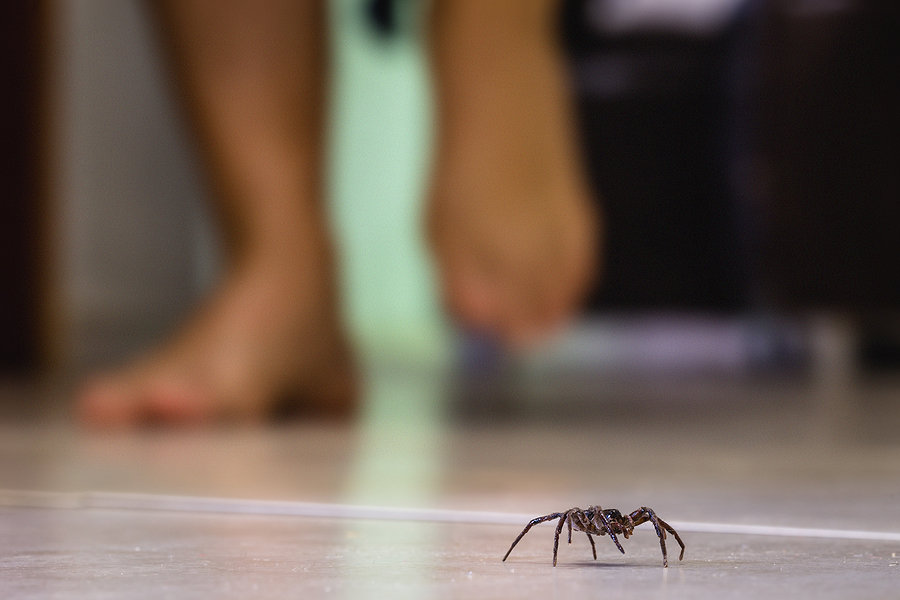
Spider sightings tend to increase when the weather cools off. While most spiders prefer to live outdoors, a few will make their way inside in search of food and water. Most spider species also mate in the fall, increasing the numbers we see as they go in search of their partner. Young spiders are born in the spring, taking the summer to grow and mature. By fall they are bigger, venturing out and starting to build their webs. All of these factors combine to increase the number of spider sightings we see near the end of the year.
There are many types of spiders common to this area, some venomous but most harmless. Here are 9 of the most common spiders in Georgia to look out for this fall.
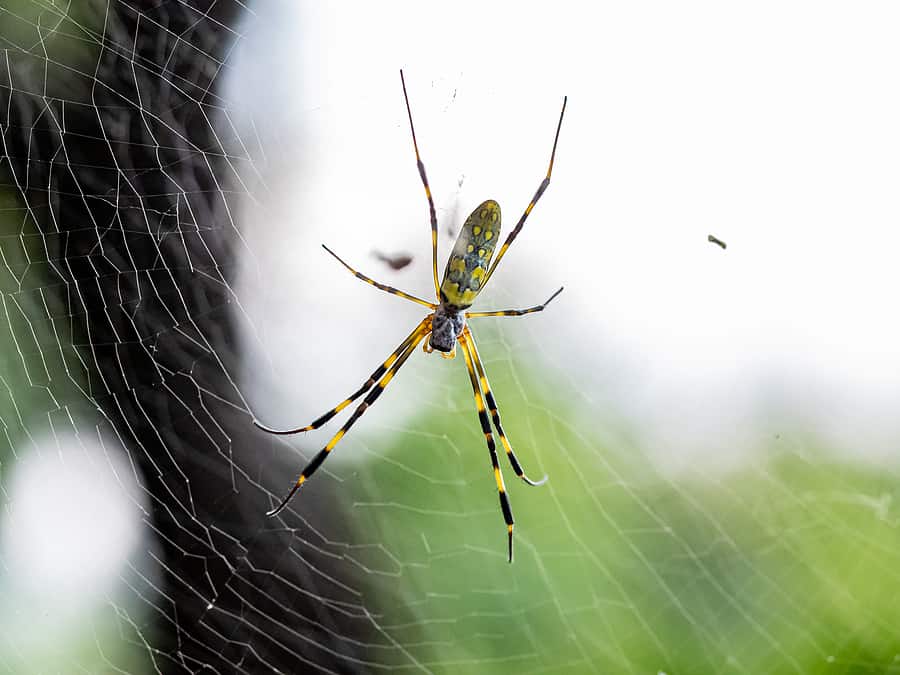
Joro spiders are a non-native species originating in Asia that were first spotted in Georgia in 2014. Since then they have started to expand their population throughout the southeastern United States. Joro spider eggs hatch in late spring, with sightings as early as May. They will build their webs anywhere they can find, including decks, porches, houses, plants, landscaping, etc. They are larger than most other spider species in the US. Females can measure up to 4″ in length with males only reaching about 1/4″ in size. Their colors vary – males are usually brown while females can be blue-gray or yellow with red markings on their abdomen and black legs with yellow bands. They are commonly found on the edges of woods and around homes. They are not usually seen indoors and their bites are rare. There is no research to show that Joro spiders are dangerous to humans.

The black widow is one of the few structure-invading species of spiders in our area. Their fangs are big enough to penetrate human skin and their venom is powerful enough to cause side effects in humans. In fact, they are the most venomous spider in North America. Antivenom for their bites does exist. Female black widows grow to lengths of 3/4″ while males are about half that size. They are one of the easiest types of spiders to spot with black bodies and distinctive red hourglass markings on the underside of their abdomen. They have very round body shapes. These spiders can be found indoors and outdoors, preferring protected, sheltered areas to live in. They are most active at night, spinning webs to catch their prey in. Outside they can be found around decks, in barns and outbuildings, under rocks, or in woodpiles. Inside they can usually be found in areas that aren’t disturbed or used frequently, such as garages, basements, closets, and crawlspaces.
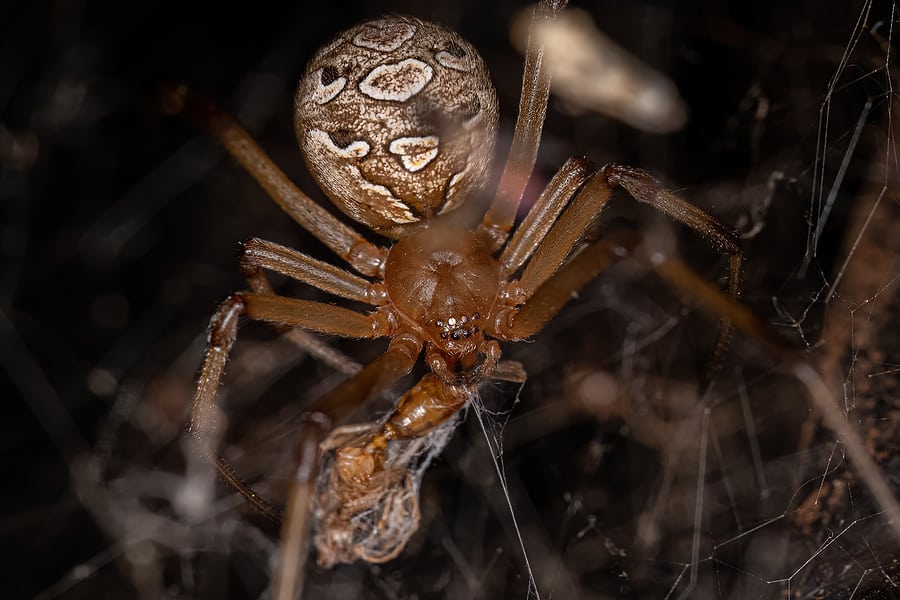
Brown widow spiders are another non-native species, although can now be found throughout the southern and western United States. Bites from the brown widow aren’t as potent as those from their black widow cousins and don’t cause nearly as bad of side effects. Only brown widow spiders bite. Brown widows also prefer undisturbed areas to live in but can often be found in garages and basements, gardens, on patio furniture, on mailboxes, on outdoor toys, and in storage closets. Female brown widows grow to about 1/2″ long while males are about half this size. Both males and females are brown in color with tan and black legs. They also have the hourglass marking like black widows, but theirs are orange in color.
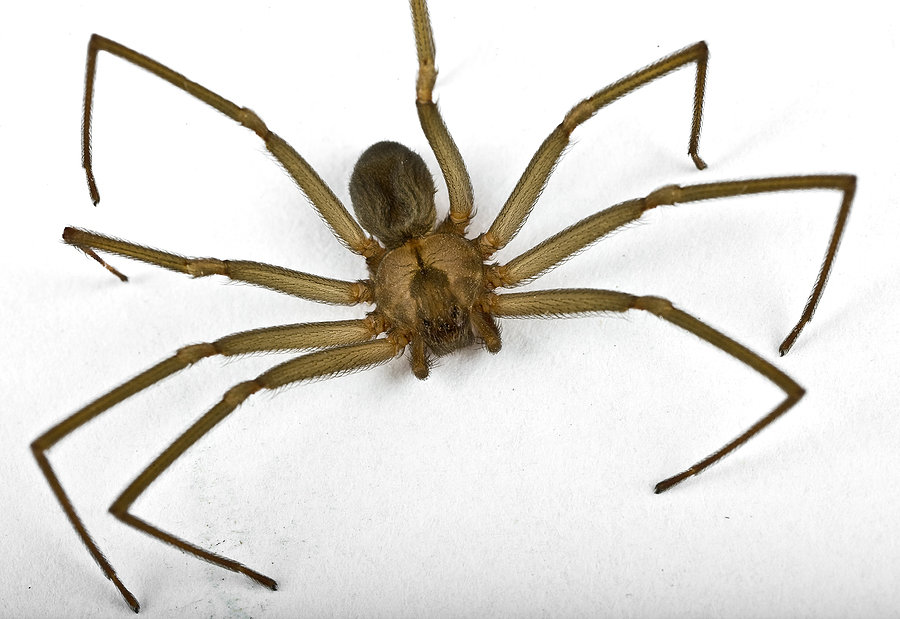
Brown recluse spiders are commonly found in the southeastern and midwestern United States. They are also easily identifiable by the distinctive markings found on their bodies. These spiders are known for “secretive” behaviors, preferring to hide in warm, dark, dry habitats. They are commonly found in woodpiles, basements, and closets, especially in old shoes that aren’t worn often. They will bite, with symptoms taking up to 3 hours to show up afterwards. Brown recluses range from 1/4″ to 1/2″ in length. They are tan to dark brown in color with a dark fiddle-shaped marking on their back.

Wolf spiders are another common species you may see this fall. These spiders don’t use webs to catch prey; instead they hunt their prey, utilizing their speed to catch them. There are over 100 species in the US and Canada. Female wolf spiders grow from 3/8″ to 1-3/8″ in length while males range from 1/4″ to 3/4″. They are usually dark brown or yellow with striped markings on their legs. They are also very hairy. Wolf spiders hunt at night and hide out during the day. Once inside, they usually stay at lower levels and are often spotted in the floor along walls and under furniture. Outside they are found in woodpiles, under rocks, and other sheltered areas of landscaping. They can be beneficial to have around because they eat other pests that can cause problems around your home. They can bite but it is extremely rare.
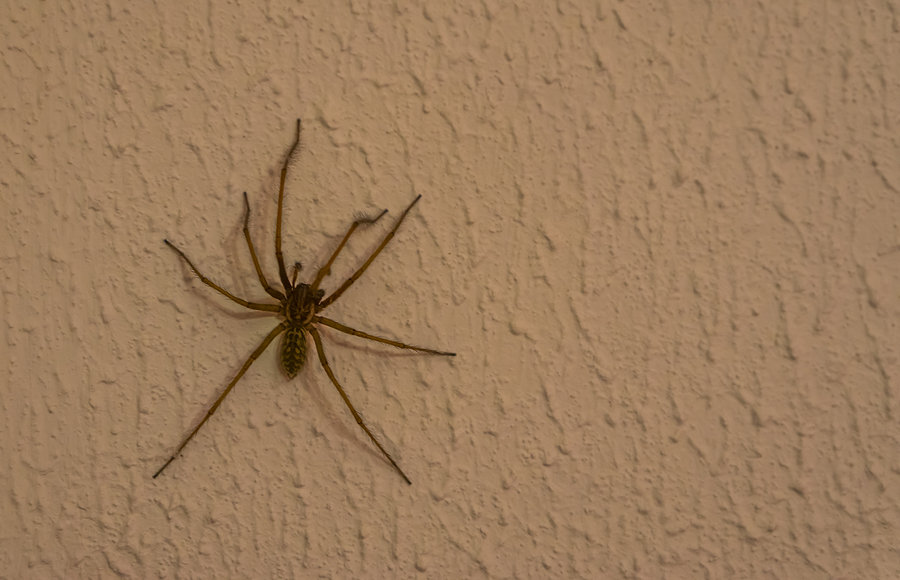
The common house spider gets its name from the fact that it is commonly found inside homes. These spiders are commonly found worldwide. They don’t pose a threat to humans and are more of a nuisance pest. Their webs in your home are the biggest issue they cause. Female house spiders grow from 3/16″ to 5/16″ in length while males range from 1/8″ to 3/16″. They are yellowish-brown in color with dirty white abdomens and dark stripes that meet at an angle.
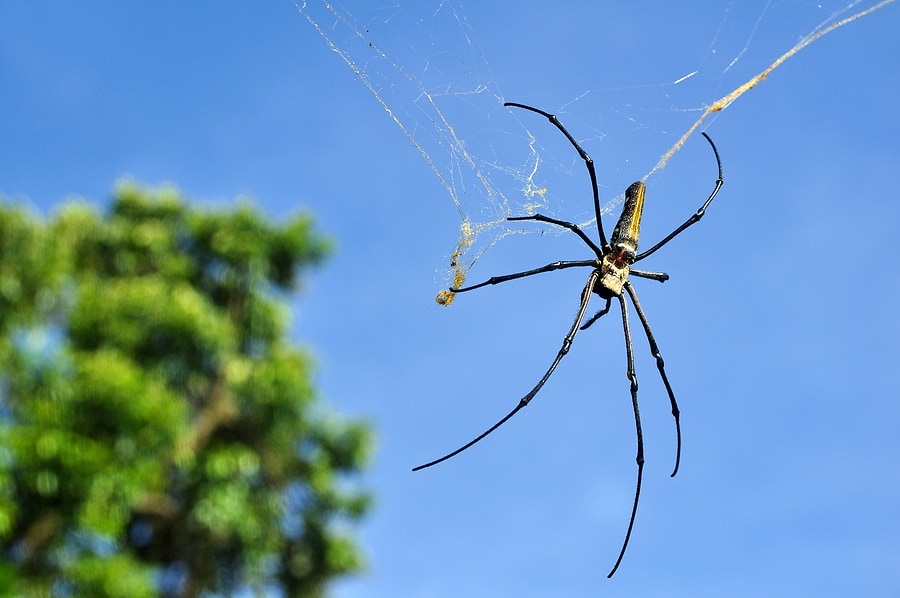
Orb weaver spiders are named for the orb-shaped webs they create. There are over 2800 species of these spiders worldwide. Adults range in size from 1/2″ to 1″. Their coloring varies greatly among species; they are mostly reddish-brown to gray but some varieties are a vibrant yellow color. Because there is such variation among species, the best way to identify an orb weaver is by it’s large, circular, wagon-wheel shaped web. Orb weavers don’t pose any threats to humans but their large webs can be problematic around your home.
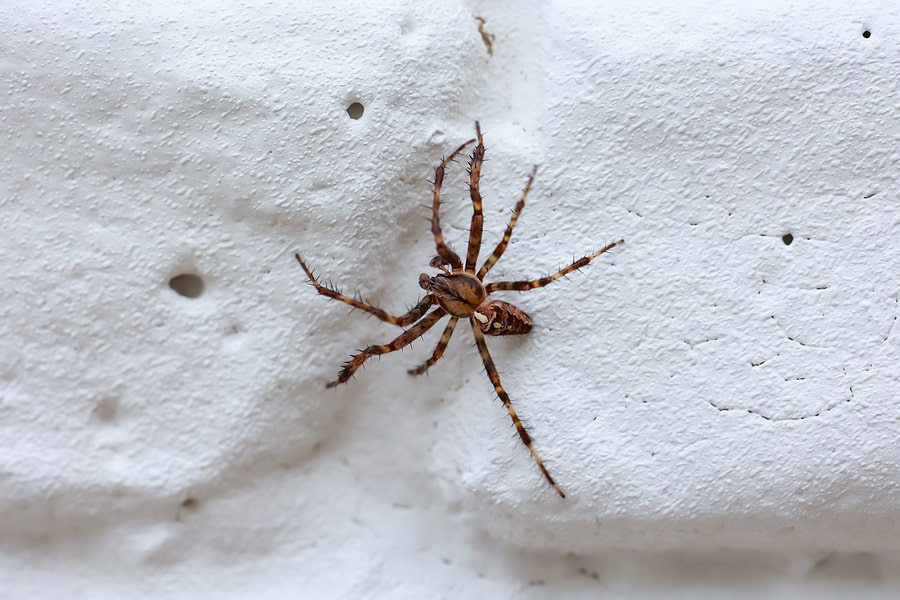
The crevice spider, also known as the southern house spider, are commonly found in the southeastern United States. They are often mistaken for brown recluse spiders. They range in size from 1/2″ to 3/4″. Males are usually brown or amber in color while females are black or gray and resemble tarantulas. They prefer to build their webs at higher elevations and are usually found on the outside of houses, outbuildings, and barns. They are known to crawl across anything in their path, including humans! They do not pose a threat to humans, however.
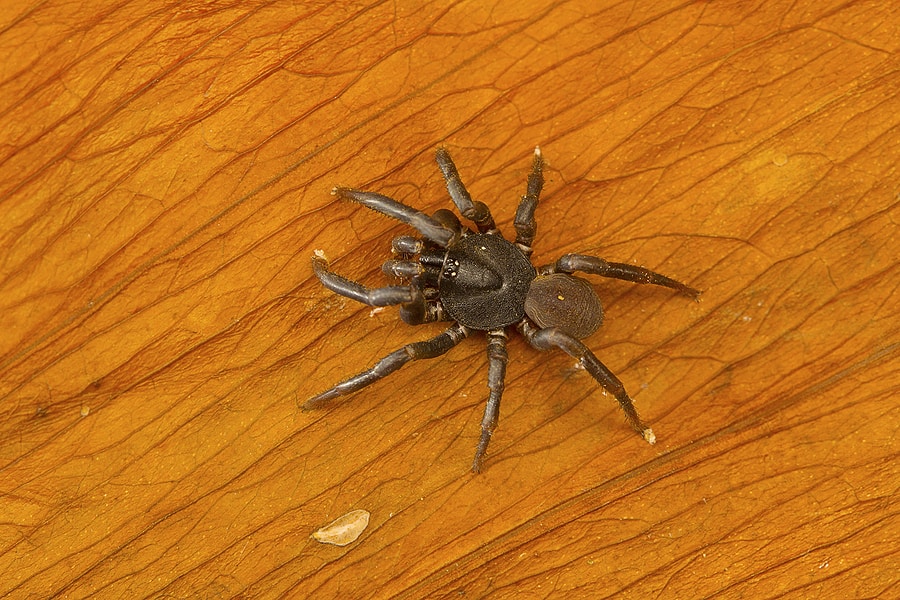
The trapdoor spider is a large, hairy spider that can range in color from yellowish brown to reddish brown to black. They have powerful jaws and sharp fangs. Trapdoor spiders get their name from the burrows they construct with a cork-like trapdoor made of soil, vegetation and silk. They spend most of their lives underground and usually hunt at night. Trapdoor spiders are not aggressive and, in fact, are often timid when confronted. They can bite but this is rare. They do not pose a significant threat to humans.
Once you’ve identified the spider(s) you have around your home, the next step is preventing them. You can prevent spiders by:
Fall Spider Identification Guide
American Cockroaches: How To Identify and Prevent
Are Mosquitoes Still Active in the Fall?
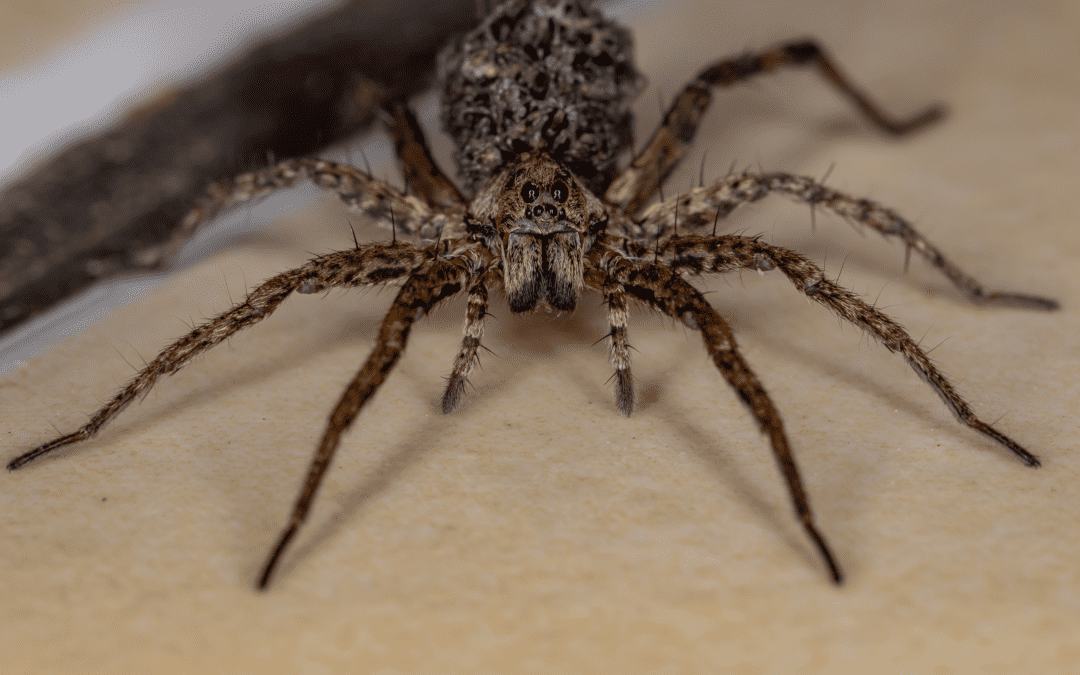
In the southern states, there are many species of spiders found and there is a good chance you’ve seen some of them. Many spiders make themselves at home in our yards, gardens, flower beds, and inside our homes. But as the weather gets cooler, you’re bound to see more spiders come inside to seek shelter from the cooler weather. Here are a few common spiders that may invade your home when the temperatures drop.
A house spider is a common name given to spiders that are primarily found inside your house. They vary in color, but most are yellow to brown with elongated abdomens. They can usually be found in ceiling corners, under furniture, and inside closets, basements, garages, and crawl spaces. When outdoors, they are often found in windows, under eaves, and near light sources.
They can be a nuisance to have but are not a threat to humans. Because of the low humidity in newer homes, house spiders are becoming less common in houses and more likely to be found in garages, sheds, barns, and warehouses.
A brown recluse spider is light to dark brown, with a signature dark brown violin shape on its back. They are commonly found outdoors in debris and woodpiles but can be found indoors usually underneath furniture, inside storage bins, and in dark recesses like baseboards. The brown recluse can also be found hiding out in closets, attics, and crawl spaces.
This spider species is one you should look out for as its bite is painful. If cornered, they will bite, leaving an ulcerating sore that must be treated by a medical professional immediately.
Wolf spiders are typically dark brown with pale markings or stripes. Their legs are long and spiny, and most have hair on their bodies. If found indoors, they are typically on the floor, especially along walls and under furniture. If found outdoors, they are usually under leaves, woodpiles, yard debris, and stones.
They can bite, but it is very rare for them to do so; even if they do it doesn’t pose a significant threat to humans. They are unique in that they don’t catch their prey in webs but will chase them down using their speed.
One of the most easily identifiable spiders in the US, these shiny, black spiders are one of the most fearsome out there. Most can identify them by their prominent red hourglass shape on their back. Black widow spiders are commonly found around woodpiles and can easily access your home by hitching a ride on your firewood. They are also found in garages, eaves, empty boxes, and even shoes that are stored away.
Females are more aggressive than males and will bite. They can be extremely harmful to humans and their bite should be taken seriously. Symptoms from a bite include fever, elevated blood pressure, nausea, and sweats. It should be treated immediately to stop any further neurological damage.
Spiders are more common in the fall and winter as they make their way indoors, so be on the lookout for these spiders once the temperature begins to drop. If you suspect a spider problem, contact your local pest control company who can help identify the type of spider you have and provide you with a thorough inspection and treatment plan that is right for you and your property.
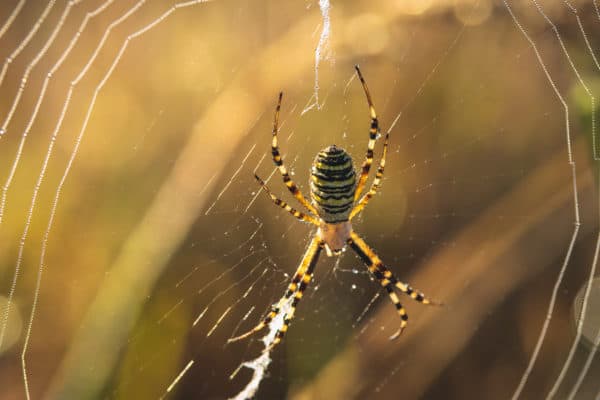
As you break out your fall decorations, you may have noticed an abundance of spider webs or had a spider run across your hand; now the house must burn! WAIT – before you jump to meme-worthy conclusions, spiders do act as nature’s form of pest control; however, having them in your home is not ideal. Follow these tips to prevent spider encounters in your home so that you can enjoy hanging up fake cobwebs without stumbling upon a real one.